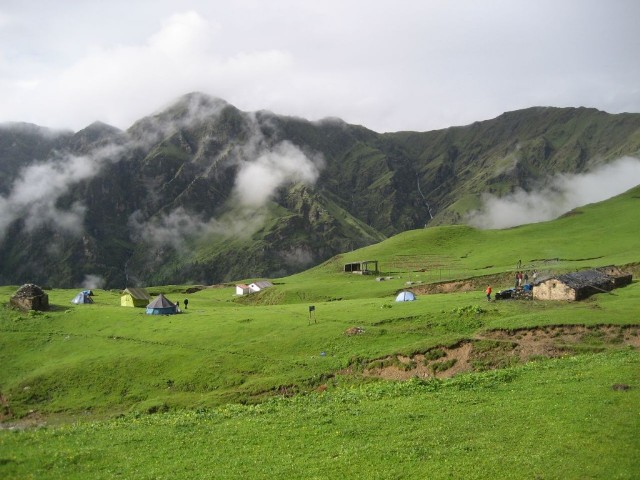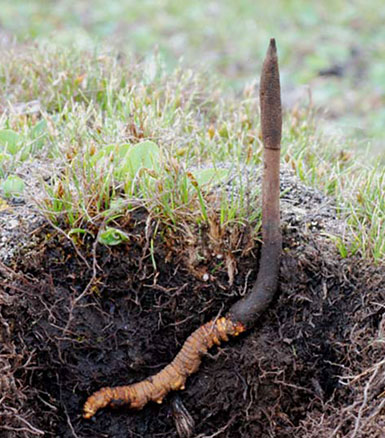Dehra Dun : The ‘bugyals’ (alpine meadows) in the higher reaches of Uttarakhand are vibrating with life. Tents dot the landscape and generators provide them with power. The evenings are dedicated to Bacchus as tired men hit the bottle before turning over for the night.
No they are not trekkers from far and wide going or coming to the glacial heights, but clandestine dealers of the fungus, yarsa gumba or keeda jadi (ophiocordyceps sinensis) camped there with residents of nearby villages who are familiar with the medicinal herb, which has a long history in traditional and Chinese medicine.

According to members of the Pangu-Askot-Aarakot Expedition 2014, which traversed about 1150 kms spread over 350 villages in 36 rivers valleys of seven of the 12 districts of this small hill state, the ‘bugyals’ have been taken over by the clandestine dealers with their entourage of locals in search of the fungus, that is found at an altitude between 3000 to 5000 metres (9800 to 16,400 ft).
They claim that tents dot the landscape at the heights and generators have been specially taken to ensure that there is power. Dish antenna keep them informed of the happenings besides providing entertainment and bottles are transported on mule backs to keep the locals in good humour, as they are the mainstay of the dealers.

Yarsa guma or keeda jadi is a fungus that parasitizes larvae of ghost moths and produces a fruiting body values not only as an aphrodisiac but also used in the treatment of kidney liver diseases and even cancer.
The fungus germinates in the living larva, kills and mummifies it and then a stalk like fruiting body emerges from the corpse.
It is yet not cultivates commercially and over-harvesting and over-exploitation have led to its classification as an endangered species in China, where it is still in great demand.
The dealers reportedly give their harvest of the fungus to Nepali traders at costs ranging from Rs 10 to 15 lakhs per kg. It is said that the traders take back the fungus by helicopters.
The western world was largely unaware of the fungus prior to 1993, when three female Chinese athletes, Wang Junxia, Qui Yunxia and Zhang Linli broke five world records for 1500, 3000 and 10,000 metre races at the Beijing National Games. This attracted attention and also suspicion and it was expected that the three would fail drug tests for anabolic steroids.
However, the tests revealed no illegal substances and their coach Ma Junren told reporters that the runners were taking ophiocordyceps sinensis and turtle blood at his request.
However, for the 2000 Sydney Olympics Ma Junren withdrew some of his athletes at the last minute as it was speculated that the new doping tests would have revealed illegal substances.
Nepal and Bhutan have developed a system for the exploitation of the fungus and ensuring that clandestine dealers do not over exploit it, there is no policy for exploitation of the fungus in this small hill state.
This is perhaps why as soon as the snow melts and the bugyals are fit for camping, dealers reach there with residents of the local villages who know the local terrain and where the fungus can be found.
Incidentally, this was the 40th year of the Pangu-Askot-Aarakot Expedition which was first undertaken in 1974. It is undertaken once every 10 years with earlier expeditions having taken place in 1984, 1994 and 2004.
Members said that in the bordering areas of Nepal, villagers on the Indian side mostly use sims of Nepali telecom companies as connectivity of India companies is very poor.
A journalist with over 40 years of experience, Jagdish Bhatt was Editor, Hill Post (Uttarakhand).
Jagdish had worked with India’s leading English dailies, which include Times of India, Indian Express, Pioneer and several other reputed publications. A highly acclaimed journalist, he was a recipient of many awards
Jagdish Bhatt, aged 72, breathed his last on 28th August 2021 at his Dehradun residence.



In the meantime, the government is busy with much more important things like virtual reconstruction and rehabilitation after 2013 tragedy on paper, as well as virtually fighting bye elections on helicopters